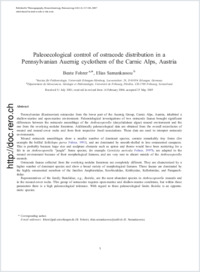Paleoecological control of ostracode distribution in a Pennsylvanian Auernig cyclothem of the Carnic Alps, Austria
- Fohrer, Beate Institut für Paläontologie, Universität Erlangen-Nürnberg, Erlangen, Germany
- Samankassou, Elias Department of Geosciences, Geology unit, University of Fribourg Switzerland
-
08.08.2005
Published in:
- Palaeogeography, Palaeoclimatology, Palaeoecology. - 2005, vol. 225, no. 1-4, p. 317-330
Anthracoporella mounds
Austria
Carnic Alps
cyclothems
Ostracodes
paleoecology
Pennsylvanian
Upper Carboniferous
English
Pennsylvanian (Kasimovian) ostracodes from the lower part of the Auernig Group, Carnic Alps, Austria, inhabited a shallow-marine and open-marine environment. Paleontological investigations of two ostracode faunas brought significant differences between the ostracode assemblage of the Anthracoporella (dasycladalean algae) mound environment and the one from the overlying nodular limestone. Additionally paleoecological data are obtained from the overall microfacies of mound and mound-cover rocks and from their respective fossil associations. These data are used to interpret ostracode environments. Mound ostracode assemblages show a smaller number of dominant species, contain remarkably tiny forms (for example the bolliid Solleikope parva Fohrer, 1991), and are dominated by smooth-shelled to less ornamented carapaces. This is probably because large size and sculpture elements such as spines and thorns would have been restricting for a life in an Anthracoporella “jungle”. Some species, for example Carnizzia auricula Fohrer, 1997b, are adapted to the mound environment because of their morphological features, and are very rare to absent outside of the Anthracoporella mounds. Ostracode faunas collected from the overlying nodular limestone are completely different. They are characterized by a higher number of dominant species and show a broad variety of morphological features. These faunas are dominated by the highly ornamented members of the families Amphissitidae, Scrobiculidae, Kirkbyidae, Kellettinidae, and Paraparchitidae. Representatives of the family Bairdiidae, e.g., Bairdia, are the most abundant species in Anthracoporella mounds and in the mound-cover rocks. This group of ostracodes requires open-marine and shallow-marine conditions, but within these parameters there is a high paleoecological tolerance. With regard to these paleoecological limits Bairdia is an opportunistic species. Anthracoporella mound ostracodes of other Pennsylvanian shelf regions have so far not been reported. As to the mound-cover ostracodes there are close relationships of the Carnic Alps ostracodes to those of the Cantabrian Mountains, Spain.
- Faculty
- Faculté des sciences et de médecine
- Department
- Département de Géosciences
- Language
-
- English
- Classification
- Geology
- License
-
License undefined
- Identifiers
-
- RERO DOC 5455
- DOI 10.1016/j.palaeo.2004.02.053
- Persistent URL
- https://folia.unifr.ch/unifr/documents/299922
Statistics
Document views: 168
File downloads:
- Texte intégral: 259
